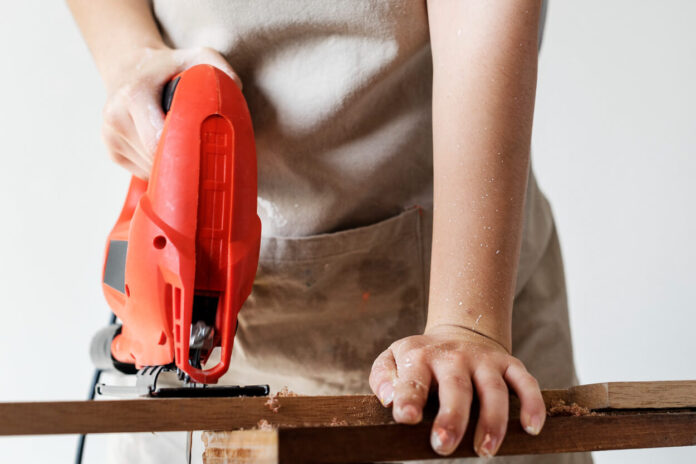Whether you’re looking to save money on home repairs, develop practical skills, or simply enjoy the therapeutic benefits of working with your hands, mastering basic hand tools is the foundation for countless DIY possibilities. I remember my first attempt at a “simple” shelf installation.
Three bent nails, one slightly crooked shelf, and a handful of colorful language later, I realized that working with hand tools is indeed a skill—one that requires practice and patience. The good news? Anyone can learn. This guide presents five approachable projects designed to build your confidence and proficiency with common hand tools. Each project introduces different techniques while creating something useful for your home. Let’s roll up our sleeves and get started!
There’s something deeply satisfying about creating with your own hands.
Simple Woodworking Projects for Practicing Hand Tools Techniques
The Classic Wooden Toolbox
Nothing symbolizes a handyperson’s journey better than creating their own toolbox. This project introduces you to measuring, marking, sawing, and assembly—foundational skills for any woodworking endeavor.
You’ll need
- handsaw
- hammer
- measuring tape
- square
- sandpaper
- wood glue
Select pine boards for their forgiveness and affordability. The design is straightforward: a rectangular box with a comfortable handle. Start by cutting your base and side pieces, ensuring square edges with your measuring tools. Sand all rough edges—a step I once foolishly skipped, resulting in splinters for days! Assemble using wood glue and finishing nails, working systematically around the box. The handle can be as simple as a dowel between two drilled holes or a carved piece for those feeling adventurous. What makes this project perfect for beginners is its functionality despite imperfections. Even with slight measurement variations, your toolbox will still hold tools.
Floating Wall Shelves
These simple yet elegant shelves teach precision in measurement and cutting while introducing the satisfaction of creating something both beautiful and useful.
Gather a
- handsaw
- level
- drill with bits
- screwdriver
- measuring tape
- pencil
Choose wood that complements your home’s aesthetic—pine works well, but maple or oak offers greater durability for heavier items. The process involves careful measuring of your wall space, cutting boards to size, sanding edges until silky smooth, and assembling brackets for mounting. The most critical skill you’ll develop here is accurate measurement—a lesson I learned the hard way after installing shelves that looked mysteriously tilted despite my “eyeballing” them as level. Take your time locating wall studs for secure mounting. There’s profound satisfaction in placing objects on shelves that don’t immediately crash to the floor—trust me on this one.
Home Repair Tasks that Improve Your Hand Tools Skills
Door and Cabinet Hardware Replacement
This seemingly simple task provides surprising depth in skill development. Updating knobs, handles, and hinges throughout your home transforms spaces while teaching precision alignment, careful disassembly, and working within existing constraints.
You’ll need
- screwdrivers (both Phillips and flathead)
- a drill
- measuring tape
- possibly a chisel for hinge recesses
Begin with a single cabinet door to build confidence before tackling the entire kitchen. The process teaches patience and problem-solving. When I replaced my kitchen hardware, I discovered that new handles didn’t align with existing holes. Rather than giving up, I learned to fill old holes with wood putty and precisely measure for new ones—a skill that’s proven useful countless times since. Pay special attention to hinge alignment on doors. That slight adjustment making the difference between a smooth-closing door and one that catches demonstrates the precision hand tools allow. The immediate feedback of this project—a smoothly opening drawer or quietly closing cabinet—provides instant gratification while building transferable skills.
Picture Frame Assembly and Wall Hanging
Creating and hanging picture frames develops multiple hand tool skills while resulting in personalized wall decor. This project introduces mitered corners—a slightly more advanced cutting technique that produces professional-looking results.
Gather a
- miter box with saw
- hammer
- finishing nails
- wood glue
- level
- picture hanging hardware
Select wood strips proportional to your chosen artwork. Cutting precise 45-degree angles for corners requires attention to detail and steady hands. Join corners using wood glue reinforced with small finishing nails. I recall my first frame having gaps you could slip a credit card through—now my corners meet so precisely they barely need glue! The hanging process teaches wall assessment (finding studs or using appropriate anchors) and precise measurement for proper alignment. There’s nothing quite like the pride of displaying photos or artwork in frames you’ve crafted yourself, knowing the skills developed will serve countless future projects.
Working with Hand Tools for Decorative Crafts: From Beginner to Advanced
Wooden Serving Board with Decorative Handle
This project combines utility with artistic expression, allowing creativity while building fundamental hand tool skills. The progression from raw lumber to finished piece demonstrates the transformative power of hand tools.
You’ll need
- a handsaw
- coping saw (for the handle design)
- files
- sandpaper of various grits
- measuring tools
- food-safe finish
Choose hardwoods like maple, walnut, or cherry for their durability and beauty. Begin by cutting your board to desired dimensions. Sketch your handle design on paper first, then transfer to the wood. The coping saw makes cutting curved shapes possible—a challenging but rewarding skill to develop. Sand extensively, moving progressively through finer grits until the surface feels like satin beneath your fingers. The finishing process teaches patience as multiple thin coats produce superior results to one thick application. I’ve given these as gifts, and the recipients’ delight upon hearing “I made this myself” makes every careful cut and sanding session worthwhile.
Remember that perfection isn’t the goal — improvement is.
These five projects build upon each other, developing complementary skills that transfer across countless applications. What begins as awkward handling of unfamiliar tools gradually transforms into confident craftsmanship. The scratched knuckles and occasional frustrated sighs give way to the profound satisfaction of creating with your own two hands.
Each project teaches not just technical skills but also patience, problem-solving, and the wisdom to know when “good enough” is actually perfect. So gather your tools, clear a workspace, and begin. Your journey to hand tool mastery starts with that first measured mark and careful cut. The skills you develop will serve you for a lifetime, while the confidence gained extends far beyond your workshop walls.
-> Go Browse Our Product Catalog
Others Also Interested
- How long will these projects take for a complete beginner?
Each project ranges from 2-4 hours of active work, though finishing processes may extend over multiple days to allow for proper drying.- Which project is best for learning how to use a specific hand tool?
The toolbox excels for learning sawing techniques, picture frames for precision measuring, and the serving board for developing sanding skills.- What materials do I need to prepare before starting these projects?
Beyond the specific tools mentioned, prepare a clean workspace with good lighting, protective gear (safety glasses and work gloves), and pre-selected quality materials.- Can children safely participate in any of these hand tool projects?
With proper supervision, children ages 8+ can assist with measuring, sanding, and finishing. Reserve cutting and drilling for teens or adults.- How can I troubleshoot if my project isn’t turning out as expected?
Step back, reassess measurements, and remember that wood filler and sandpaper can remedy many mistakes. Consider each “failure” valuable education for future projects.
-> Go Browse Our Product Catalog



